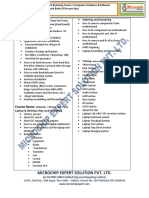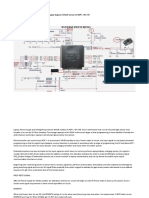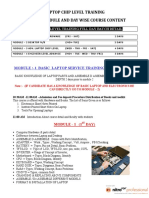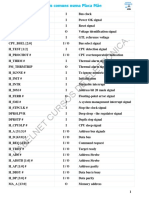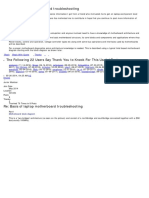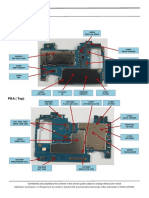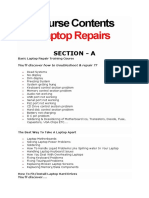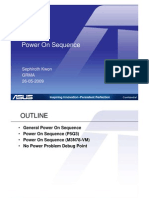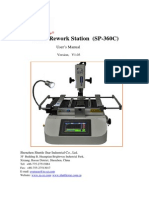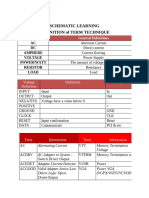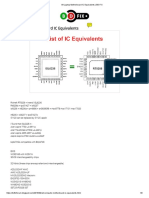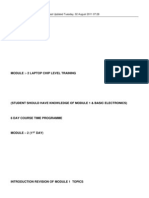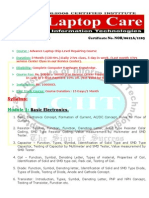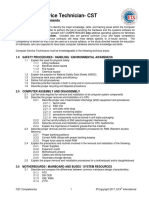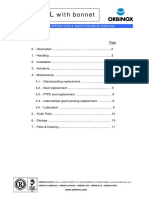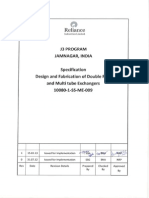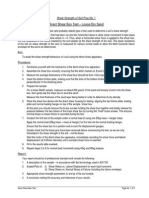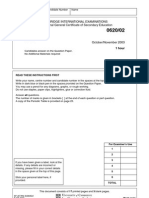Chiplevel Repairing
Chiplevel Repairing
Uploaded by
shriram1082883Copyright:
Available Formats
Chiplevel Repairing
Chiplevel Repairing
Uploaded by
shriram1082883Original Description:
Copyright
Available Formats
Share this document
Did you find this document useful?
Is this content inappropriate?
Copyright:
Available Formats
Chiplevel Repairing
Chiplevel Repairing
Uploaded by
shriram1082883Copyright:
Available Formats
Advance Chip level with BGA Technology
Duration : 3 Month (120 Hrs.) Daily 2 hrs class, 5 day in week.
(Last month 4 hrs service Center Class in our Service Center).
Eligibility : Complete Computer Hardware Knowledge
Course Fee : Rs-------/- (For Service Center Training) =
Rs. ------/- In case of 1 Shot Payment 10% off.
(Not Valid for Service Center Course Fee).
Installment : Rs. --------/-
Fast Track Course Duration: 2 Month
Course content :
Module 1: Basic Electronics.
1. Basic Electronics Concept, Formation of Current, AC/DC Concept, Rules for Flow of Current.
2. Resistor- Symbol, Function, Function, Denoting Letter, Solid Type Resistor Color Coding,
SMD Type Resistor Coding, Value measurement by Multimeter and SMD Tester.
3. Capacitor Function, Types, Symbol, Identification of Solid Type and SMD Type Capacitor,
Testing of Capacitor by Multimeter and SMD Tester, Value measurement by SMD Tester.
4. Coil Function, Symbol, Denoting Letter, Types of material, Properties of Coil,
Identification of Solid and SMD type coil, Pack coil, Testing of Coil.
5. Diode: Function, Symbol, Denoting letter, Identification of Solid and SMD Type Diode,
Types of Diode, Testing of Diode, Anode and Cathode Concept.
6. Transistor: Introduction, Types, Symbol, Denoting Letter, PNP and NPN Concept, Testing of
Transistor, Function etc.
7. Mosfet: Introduction, Types, 3 leg Mosfet, 8 Leg Mosfet, Identification of N-Channel and P-
Channel Mosfet, Testing of Mosfet, Dual Mosfet Concept, Switching Concept Etc.
8. Crystal: Introduction, Concept of Quartz, Clock and Pulse, Measuring unit, Types and Real
Shape, Testing of Crystal etc.
9. Transformer and IC.
Module 2: Chip level Practice with Testing & Repairing Tools.
Use of Soldering Iron, Micro Soldering Iron, Desoldering Pump, File, Twiser, SMD Machine and Hot Melt
Gun, All types of IC and Chip soldering/ Desoldering, All types of Electronic Component Solid and SMD
soldering /Desoldering.
Module 3: Chip Level Circuit Tracing and Repairing of Motherboard.
1. Motherboard overview and Block Diagram of Motherboard.
2. Identification of all types of chip, ports, socket, slots etc.
3. Working Concept of Motherboard. Concept of RESET, READY, CLOCK Signal.
4. VRM Circuit- Overview, Tracing, Hot Testing, Shorting Problem in VRM Circuit, Troubleshooting,
Internal Structure of VRM Chip, Volt Sense Circuit Concept, Programmable circuit, VID Concept.
5. RAM Supply: Identification of all Types of Desktop RAM, RAM Operating Voltage, RAM Supply
Pin, All types of possible circuit of RAM Supply. Hot Testing.
6. Clock Generator Circuit: Identification of Clock Generator, Tracing, Use of Frequency Counter to
measure Clock, Troubleshooting.
7. USB Port Circuit: USB Port Supply Pin Tracing, Data Pin Tracing.
8. Sound Circuit: Tracing, Supply Circuit of Sound Chip.
9. PS 2 Port Circuit: Pin Details of PS 2 Port, Supply Circuit, DATA and CLOCK Circuit.
10. SATA Port : Data Pin Tracing of Sata Port.
11. Sound Circuit Tracing, Supply, Troubleshooting.
12. Standby Circuit : StandbyMosfet, Circuit tracing.
13. PCI Slot: Voltage, Data and Signal Testing.
14. Diagnostic Card: LED Status , Coding Concept
15. CRO Machine: Complete Operating of CRO for Voltage, Data and Signal Testing.
16. ROM Circuit: Identification of all Types of ROM, ROM Pin Details and Circuit Tracing.
17. ROM data and RAM Data: Data Testing on ROM and RAM Data Pin.
18. South Bride Supply Circuit.
19. Repairing of RAM.
20. PS ON and Trigger Circuit.
21. BIOS Programming by Mini and Universal BIOS Programmer.
22. How to Check CPU Socket by CPU Socket Tester.
Module 4: Chip Level Laptop Hardware Concept.
1. Assembling and Dissembling of Laptop.
2. Identification of all parts of Laptop.
3. Identification and Function of all Ports and Socket of Laptop.
Module 5: Chip level Circuit Tracing and Repairing of Laptop.
1. Volt in Circuit. Tracing and Troubleshooting.
2. VRM Circuit. Tracing and Troubleshooting.
3. Ram Supply Circuit. Tracing and Troubleshooting.
4. Step Down Circuit 5 Volt and 3.3 Volt. Primary and Secondary Step down.
5. Battery Charging and Discharging Circuit. Tracing and Fault Finding.
6. Clock Generator Circuit.
7. Fan Controller Circuit.
8. USB Supply and Data Circuit.
9. SATA Supply and Data Circuit.
10. LAN
11. AUDIO Mike, Headphone and Internal Speaker Circuit Tracing.
12. CPU Thermal Circuit.
13. ROM Identification of all types of ROM and Circuit Tracing.
14. Schematic Diagram Laptop Motherboard Circuit Tracing through Schematic Diagram.
15. North Bridge Supply
16. South Bridge Supply
17. Graphics Chip Supply
18. Concept of PCH.
19. Laptop BIOS Programming.
20. BGA Machine Operation, Chip Rebolling.
21. How to Download BIOS File from Internet.
22. Password Removal Tips.
23. VGA Port.
24. Input Output Controller chip Connection Circuit,
25. Use of DC Supply Machine.
26. Laptop Display Assembly.
27. Concept of RESET.
28. Identification of all chip of laptop motherboard.
29. Common Faults of Laptop and Troubleshooting.
You might also like
- Laptop Training Shri Ram SyllbusDocument4 pagesLaptop Training Shri Ram SyllbusAnthony Lobo75% (4)
- Laptop Chip Level Course PDFDocument2 pagesLaptop Chip Level Course PDFMukesh Yadav100% (1)
- Mosfet Type On Laptop MotherboardDocument9 pagesMosfet Type On Laptop Motherboardkemal127100% (2)
- Advance Reparining by Gaurav - PPSXDocument7 pagesAdvance Reparining by Gaurav - PPSXMamaZote TechNo ratings yet
- Laptop Voltage Requirement and Power Supply DiagramDocument5 pagesLaptop Voltage Requirement and Power Supply Diagrambong bernalbongNo ratings yet
- Laptop Chip Level Training Full Day Module and Day Wise Course ContentDocument23 pagesLaptop Chip Level Training Full Day Module and Day Wise Course ContentJawad AnwarNo ratings yet
- Report On Security System Switcher (Oct 2011)Document19 pagesReport On Security System Switcher (Oct 2011)scribdsunshineNo ratings yet
- Flame Arrestor Data SheetDocument1 pageFlame Arrestor Data SheetErnesto100% (1)
- Embraco CatalogueDocument102 pagesEmbraco Catalogueshank1000% (1)
- Laptop Course DeailesDocument16 pagesLaptop Course DeailesMukesh Yadav100% (1)
- 1 Month Laptop Repairing CourseDocument10 pages1 Month Laptop Repairing CourseChiptroniksInst0% (1)
- Course Structure of Laptop Chip Level TrainingDocument10 pagesCourse Structure of Laptop Chip Level TrainingBivek BasnetNo ratings yet
- Hardware and Networking Course - Dead Problem Trouble ShootingDocument15 pagesHardware and Networking Course - Dead Problem Trouble ShootingCreative Laptop SolutionsNo ratings yet
- Laptop Components IdentifyDocument4 pagesLaptop Components IdentifyTanishsadan ANo ratings yet
- Asus Mainboard Advanced Maintenance MethodsDocument18 pagesAsus Mainboard Advanced Maintenance MethodsTuqeer KhanNo ratings yet
- Signal Code of Laptop SchemeticDocument5 pagesSignal Code of Laptop Schemeticvinu100% (1)
- How Laptop Motherboard Charging IC Works With Visual EffectsDocument4 pagesHow Laptop Motherboard Charging IC Works With Visual EffectsMohamed B Ali100% (2)
- Chip Level Training in Ahmedabad and Chip Level Repairing Course in AhmedabadDocument20 pagesChip Level Training in Ahmedabad and Chip Level Repairing Course in AhmedabadJinali ShahNo ratings yet
- Step by Step Troubleshooting of No Display Problem in Laptop MotherboardDocument5 pagesStep by Step Troubleshooting of No Display Problem in Laptop MotherboardJawad AnwarNo ratings yet
- Ic ListDocument8 pagesIc ListAvik Ghara100% (1)
- Laptop SchematicDocument111 pagesLaptop SchematicnegrusrlNo ratings yet
- Laptop Repair DellDocument1 pageLaptop Repair DellArie PrsNo ratings yet
- How To Fix Bios ME Region ProblemDocument2 pagesHow To Fix Bios ME Region ProblemD Expert100% (3)
- Basics of Laptop RepairDocument17 pagesBasics of Laptop RepairAnshad Edavana100% (1)
- SM M127 TroubleshootingDocument37 pagesSM M127 TroubleshootingYsrael Agurto Sejuro100% (3)
- Chip Level Laptop Repairing InstituteDocument6 pagesChip Level Laptop Repairing InstituteMagzoub NourNo ratings yet
- Adiedkhaz Book of Laptop IndexDocument5 pagesAdiedkhaz Book of Laptop Indexavancealdemar56No ratings yet
- Chip Level Laptop Repairing Institute PDFDocument10 pagesChip Level Laptop Repairing Institute PDFMagzoub NourNo ratings yet
- Course For System RepairingDocument7 pagesCourse For System RepairingKAVIYARASANNo ratings yet
- Notebook Power System Introduction TroubleshootingDocument44 pagesNotebook Power System Introduction Troubleshootingglepunk100% (1)
- Determine If Your Motherboard Is DeadDocument8 pagesDetermine If Your Motherboard Is DeadSasi DharanNo ratings yet
- Card Level Laptop DesktopDocument2 pagesCard Level Laptop DesktopJawad Anwar100% (1)
- Power On Sequence IntroductionDocument8 pagesPower On Sequence Introductionmimelendeza100% (1)
- All Rights ReservedDocument22 pagesAll Rights ReservedLisandro Martinez DominguezNo ratings yet
- SP 360 CmanualDocument35 pagesSP 360 CmanualencontreelrepuestoNo ratings yet
- Laptop Chip Level Repair Classroom Notes PDFDocument108 pagesLaptop Chip Level Repair Classroom Notes PDFLenin BabuNo ratings yet
- Lap Top Repair Book Chapter 2 Chapter11 Analysis of Wistron OEM Laptop CircuitDocument58 pagesLap Top Repair Book Chapter 2 Chapter11 Analysis of Wistron OEM Laptop CircuitIsaac Perez100% (1)
- LCD Common Bad Phenomenon and Repair Methods (Figure)Document14 pagesLCD Common Bad Phenomenon and Repair Methods (Figure)Minh Nguyen100% (1)
- Dictionary For Phone RepairingDocument104 pagesDictionary For Phone RepairingJean Paul Muvara Kabiligi100% (1)
- How To Check 3v1Document12 pagesHow To Check 3v1jonas consina100% (2)
- Chip Level Repairing Classroom Notes PDFDocument56 pagesChip Level Repairing Classroom Notes PDFMurad ChowdhuryNo ratings yet
- How To Clear Motherboard Cmos BatteryDocument12 pagesHow To Clear Motherboard Cmos BatteryAndrea De Marco100% (1)
- Dell Beep CodeDocument1 pageDell Beep CodeBivek BasnetNo ratings yet
- Laptop Repair Tutorial (Chip Level) (2nd Edition) - 1Document150 pagesLaptop Repair Tutorial (Chip Level) (2nd Edition) - 1Haftamu100% (1)
- Laptop Repairing Course - Laptop Repairing InstituteDocument6 pagesLaptop Repairing Course - Laptop Repairing Institutesahil kumarNo ratings yet
- Bios Motherboard TroubleshootingDocument14 pagesBios Motherboard TroubleshootingAfdoal Al Bimani50% (2)
- Schematic Learning Definition of Term Technique: Basic Terms General DefinitionsDocument8 pagesSchematic Learning Definition of Term Technique: Basic Terms General DefinitionsKifaru Micro-electronics100% (1)
- All Laptop Motherboard IC Equivalents - BD-FIXDocument9 pagesAll Laptop Motherboard IC Equivalents - BD-FIXChami NdaNo ratings yet
- Motherboard Power Timing Knowledge AnalysisDocument5 pagesMotherboard Power Timing Knowledge Analysisabhilashvaman5542No ratings yet
- Notebook Power System Introduction & TroubleshootingDocument44 pagesNotebook Power System Introduction & TroubleshootingLeth ComputerRepair100% (1)
- SM-J730FM F G GM Common Tshoo 7Document32 pagesSM-J730FM F G GM Common Tshoo 7safaat ohsafaatNo ratings yet
- Dead Phone Testing1Document12 pagesDead Phone Testing1HEM SHRESTHANo ratings yet
- APPLE Laptop Repair Course in Mumbai - ShriRam InfotechDocument7 pagesAPPLE Laptop Repair Course in Mumbai - ShriRam InfotechRamalingam Rathinasabapathy EllappanNo ratings yet
- Module:-2 Laptop Chip Level TrainingDocument15 pagesModule:-2 Laptop Chip Level TrainingKevin TateNo ratings yet
- Computer Monitor RepairDocument53 pagesComputer Monitor RepairraveensanjeewaNo ratings yet
- Power Delivery System in MotherboardsDocument29 pagesPower Delivery System in MotherboardsAbubakar Siddiq HolmNo ratings yet
- General Laptop Power Supply Diagram (VALW Section of ADP+,+3V,+5V)Document3 pagesGeneral Laptop Power Supply Diagram (VALW Section of ADP+,+3V,+5V)Leth ComputerRepair100% (2)
- Laptop Chip Level Repairing Course SyllabusDocument4 pagesLaptop Chip Level Repairing Course SyllabusLciit LaptopCare100% (1)
- Basic Electronics ConceptDocument4 pagesBasic Electronics ConcepttekleNo ratings yet
- Laptop Motherboard Training Level 2 Online Syllabus - CompressDocument9 pagesLaptop Motherboard Training Level 2 Online Syllabus - CompressarjunNo ratings yet
- Best Chip Level Laptop Repairing Course SyllabusDocument6 pagesBest Chip Level Laptop Repairing Course SyllabusKrishna TiwariNo ratings yet
- IS11.6 SiC Device ReliabilityDocument64 pagesIS11.6 SiC Device Reliabilityshriram1082883No ratings yet
- NEPP BOK 2016 GRC Boomer SiC TN35760Document28 pagesNEPP BOK 2016 GRC Boomer SiC TN35760shriram1082883No ratings yet
- 10.21307 - Ijssis 2020 019Document9 pages10.21307 - Ijssis 2020 019shriram1082883No ratings yet
- Desktop Board VC820 Specification Update: Release Date: May 2001Document18 pagesDesktop Board VC820 Specification Update: Release Date: May 2001shriram1082883No ratings yet
- Syllabus For The Trade: (Trade Technology - I &trade Technology - Ii)Document30 pagesSyllabus For The Trade: (Trade Technology - I &trade Technology - Ii)shriram1082883No ratings yet
- Computer Service Technician-CST: Competency RequirementsDocument8 pagesComputer Service Technician-CST: Competency Requirementsshriram1082883No ratings yet
- CLOUD TV 32SH User ManualDocument18 pagesCLOUD TV 32SH User Manualshriram1082883100% (1)
- Intel Desktop Board VC820: Technical Product SpecificationDocument122 pagesIntel Desktop Board VC820: Technical Product Specificationshriram1082883No ratings yet
- Spotlight Cam Battery MANUAL WebDocument27 pagesSpotlight Cam Battery MANUAL Webshriram1082883No ratings yet
- CPTE: Certified Penetration Testing Engineer: (5 Days)Document5 pagesCPTE: Certified Penetration Testing Engineer: (5 Days)shriram1082883No ratings yet
- Basic Knowledge Requirements For Cybersecurity and HackinDocument65 pagesBasic Knowledge Requirements For Cybersecurity and Hackinshriram1082883No ratings yet
- Unix 3 Unix Services v1Document41 pagesUnix 3 Unix Services v1shriram1082883No ratings yet
- LG G5 Repair Guide: 2016 EditionDocument20 pagesLG G5 Repair Guide: 2016 Editionshriram1082883No ratings yet
- With Bonnet: ModelDocument11 pagesWith Bonnet: ModelSamet BabaNo ratings yet
- 2019 2020 - Ipox Brochure ENDocument15 pages2019 2020 - Ipox Brochure ENlongNo ratings yet
- 11th Period M2 ScienceDocument34 pages11th Period M2 ScienceTeethat LarnroongrojNo ratings yet
- High Performance in Small Sizes: Miniature Cylindrical Proximity SensorDocument8 pagesHigh Performance in Small Sizes: Miniature Cylindrical Proximity SensorСања БанковићNo ratings yet
- Metl-Span CF Urethane Insulated Panels Weight, PSFDocument1 pageMetl-Span CF Urethane Insulated Panels Weight, PSFKennyNo ratings yet
- Corken ManualDocument24 pagesCorken Manualطارق سويد100% (1)
- Materials ListDocument19 pagesMaterials ListBenjie LatrizNo ratings yet
- Common Defects in ConstructionDocument27 pagesCommon Defects in Constructionwew wewewNo ratings yet
- DLL March 14-18Document15 pagesDLL March 14-18Jan Bryan EslavaNo ratings yet
- 2 Metal PDFDocument40 pages2 Metal PDFNORIO GAMING YTNo ratings yet
- IC Fabrication Process: Course: VLSI DesignDocument14 pagesIC Fabrication Process: Course: VLSI DesignDwayne WaltonNo ratings yet
- Austroads Webinar-Pavement Design Guide To Pavement Technology Parts 2 and 4CDocument59 pagesAustroads Webinar-Pavement Design Guide To Pavement Technology Parts 2 and 4CAnggi NoviNo ratings yet
- Chapter 8. NGL Recovery-Lean Oil Absorption-1Document24 pagesChapter 8. NGL Recovery-Lean Oil Absorption-1Vikash Kumar ShuklaNo ratings yet
- Lithonia Floodlighting Brochure 1989Document14 pagesLithonia Floodlighting Brochure 1989Alan MastersNo ratings yet
- Sabic 500PDocument2 pagesSabic 500Pyohannesafework07No ratings yet
- Replacement Parts For 3M Pneumatic Orbital Sander 28527 PartsDocument4 pagesReplacement Parts For 3M Pneumatic Orbital Sander 28527 Partsskyler summersNo ratings yet
- Fiddle III 50ccDocument187 pagesFiddle III 50ccMinh ChuNo ratings yet
- Doublepipe and Multipipe Heat ExchangerDocument21 pagesDoublepipe and Multipipe Heat Exchangerpec21102002No ratings yet
- An Introduction To Recycling - StuffDocument2 pagesAn Introduction To Recycling - StuffJames MaxwellNo ratings yet
- Hsi Crusher 5260 Spec Sheet EnglishDocument2 pagesHsi Crusher 5260 Spec Sheet EnglishEduardo QuiñonesNo ratings yet
- Wedm: Influence of Machine Feed Rate in Machining Titanium Ti-6Al-4V Using Brass Wire and Constant Current (4A)Document6 pagesWedm: Influence of Machine Feed Rate in Machining Titanium Ti-6Al-4V Using Brass Wire and Constant Current (4A)Gopinath GangadhariNo ratings yet
- Qatar Civil DefenceDocument2 pagesQatar Civil DefenceguruuptoNo ratings yet
- Calc Electrode ConsumptionDocument3 pagesCalc Electrode ConsumptionNejat AbabayNo ratings yet
- Geomechanics - Lab Session No 8 - Direct Shear Test SheetDocument2 pagesGeomechanics - Lab Session No 8 - Direct Shear Test SheetharinderNo ratings yet
- WELLS Dental MaterialsDocument9 pagesWELLS Dental MaterialskuntsutsuNo ratings yet
- Chemistry: Cambridge International Examinations International General Certificate of Secondary EducationDocument20 pagesChemistry: Cambridge International Examinations International General Certificate of Secondary EducationVarun PanickerNo ratings yet

